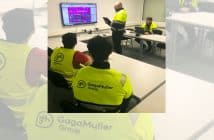Dominic Thasarathar is Autodesk’s Strategist for Construction, Energy, and Natural Resources. Irish building magazine spoke to him about his work, Autodesk’s BIM R&D, the company’s software offerings available on subscription, how cloud computing and technology will change how professionals work in a revolutionised construction industry and Autodesk’s role in this.
Please tell us about your work on Autodesk’s long-term strategies for the AEC industry?
Within AEC, I am responsible for the long-term strategy for the construction, energy and natural resources segments. Over the next ten years, my role is to see what’s happening in those industries and identify trends. I also examine the technology trends within the sectors then bring those two things together to create a vision for the future.
What can you tell us about Autodesk’s current Research and Development work?
We are active in a number of technology fields, for example, cloud technologies, generative design (smart algorithms that can help speed up and investigate design options), and 3D printing. Autodesk recently opened its Boston-based Autodesk Building, Innovation, Learning and Design (BUILD) Space, a workshop and innovation studio focused on the future of making things in the built environment.
What new software and technology will transform the AEC industry in the coming decade?
The idea of cloud computing is fascinating and exciting, particularly the ability to harness large amounts of computer processing power to solve complex design challenges. Digital fabrication technologies, like 3D printing, hold the potential to significantly disrupt the physical construction process – going from design to a physical structure in a short time and a limited number of operations. As we digitally ‘light-up’ our built environment, the Internet of Things (IoT) will change how we manage our cities, and create new opportunities to add value.
How will this change how AEC professionals work?
A new completive landscape is emerging for AEC companies. In the future, any company, regardless of size, location, and capital, will have access four new capabilities. Organisations will have access to vast amounts of processing power in the cloud to solve complex problems quickly. In addition, they will have the ability to connect talent together to get the best ideas via the internet, the ability to merge the digital and physical worlds, and free access to capital through trends like crowdfunding. One impact is likely to be industry professionals will move closer to the client, focussing on the end outcomes those clients are seeking to achieve.
Please tell us about what new services and products Autodesk are offering and how these can improve how professionals work?
A major area here is automation of the job-site and joining the office to the job-site through cloud-based tools such as BIM 360 Field, Autodesk Glue and Docs. There are numerous offerings available and these can be found on the Autodesk websites.
With regards our innovation, we have been making a transition to offer our products as a service, on subscription. The subscription model is attractive to customers, it frees up the customer from the traditional requirement of paying for perpetual licenses. With the cloud, we are offering services which free customers from the desktop. We also have the Forge platform, where third-party developers can create functionality.
What are customers asking for with regards software design and capability?
They seek connectivity and ease of use. They want functionality and we are aligning our offerings with their needs.
What software deals does Autodesk offer small and medium-sized enterprises (SMEs)?
You can find many of our software deals by navigating to Autodesk.com or discussing your requirements with your Autodesk value-added reseller.
Can you please tell us what Autodesk has to offer those starting on their BIM Journey?
There are a number of trial options. We have developed an infrastructure in the past few years to facilitate the transition to BIM. We have provided educational services to schools and universities to make our software accessible to students. And we have also offered consultancy services. We work with channel services who can help companies on the BIM Journey to help them become BIM enabled.
Is there any software advice you would like to give Irish AEC professionals?
Be bold! The computing processing and software is becoming increasingly powerful. Turning to digital tools is going to be a big part of the future of the industry. There is a generational opportunity to try things out, to test business ideas and determine what your future is going to be in the industry.
How will the work of AEC software providers change in the coming years with the ever increasing capability of computers?
It is our job, we and our peer groups’ job to light the way. I get asked a lot about what the future of the industry will be like and what technology people will need to be aware of. I think it is our job to create meaningful potential from technology trends and to show people the way to harnessing that digital capability.
What are Autodesk’s BIM goals for the next few years?
To continue to produce software to imagine, design and create a better world. It is an exciting time. Technology is offering new ways of doing things, moving the industry beyond traditional architecture and engineering, enabling AEC professionals to address the bigger questions relating to our built environment.
If you want to know more about Autodesk’s offerings or have any questions relating to the company’s software, please contact John Bennett, Autodesk AEC Manager Ireland: email john.bennett@autodesk.com




